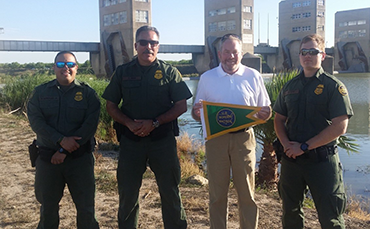
Strategies and solutions to meet present-day border patrol needs were the focus of a recent event attended by Sentrillion and the Border Commerce and Security Council (BCSC). The visit to the Department of Homeland Security (DHS), U.S. Customs and Border Protection (CBP) at the Rio Grande Valley Sector Headquarters reinforced how much personnel, technology and infrastructure has evolved to keep up with U.S. Immigration policy changes since the Office of Border Patrol’s (OBP) inception in 1924.
Joined by a host of engineering and manufacturing companies that provide industry-essential products—including surveillance, sensor and telecommunication devices—the group toured the Rio Grande Valley’s border. Located on the northern bank of the river separating the United States and Mexico, the Rio Grande Valley sector was once considered sleepy territory. It is now recognized as one of the busiest sectors for unauthorized migration into the U.S. In fact, the week prior to Sentrillion’s visit OBP detained more than 2,000 undocumented immigrants.
Manuel Padilla, the Border Patrol’s Rio Grande Valley sector chief, discussed activity levels in their unique terrain. Overall, the sector experiences 40% of all marijuana seized on the southern border and 40% of all undocumented immigrants detained. This year alone, the sector has witnessed a 300% spike in gangs from MS13 and 18th Street. Now that tattoo markings, which increase the likeliness of identification, have intentionally become less prevalent among gang members, the Border Patrol at Rio Grand Valley faces a new hurdle.
Due to improvements in the Mexican economy, the percentage of border detainees originating from Mexico has dropped, falling from 98%. These days, apprehension of Central Americans on the U.S. border has now risen to the same level as Mexican apprehension. A vast number of undocumented immigrants hail from Central America’s Northern Triangle (e.g., El Salvador, Guatemala and Honduras). CBP projects the flow of this undocumented migration from the Northern Triangle may be more difficult to deter and, once deported, there is a high probability of recidivism. CBP continues its efforts to implement solutions that provide relief from these evolving border pressures.
The agency’s current strategy emphasizes: 1) information gathering 2) intelligence integration with other local, state and federal agencies and 3) rapid response. This three-prong approach creates a greater level of situational awareness through the integration of technology information and intelligence, which has already transformed OBP from a resource-based organization to a risk assessment one. By now focusing resources on the geographic locations of greatest risk, CBP can reduce initial and return migration of undocumented immigrants to the U.S.
Related content:
- “The Shift FY1992 to 2016” is a video short showing the shift in illegal activities at U.S. borders over time and how Border Patrol agents have adapted.
- Manual Padilla discusses his transfer from the previously heavily trafficked Tucson sector to Rio Grande Valley in an article, titled, “Can This Man Secure the Border?“